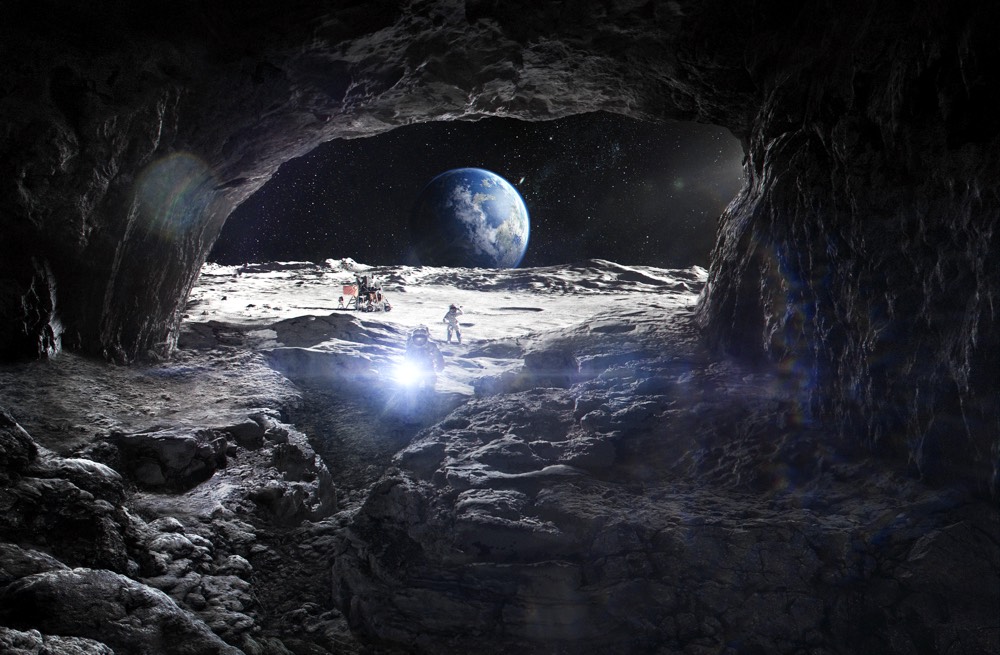
The moon is the closest neighbor of the Earth, and now mankind continues to actively study our satellite. Not so long ago, the Chinese sent a station to the moon, which completed a number of scientific tasks. Now the European Space Agency plans to join the direct study of the moon. Only not its surface, about which still much is known, but caves.
Yes, there are caves on the moon, and quite a few. Some of them can serve as a reliable shelter for lunar colonists, which will allow them to avoid a number of dangers that threaten the surface. ESA has collected many ideasproposed by scientists and engineers and selected the five most promising. Then another stage of selection followed, so now the agency has three ideas that are planned to be implemented. They are all interconnected.
What did you choose in the end?
The first idea is a preliminary survey of caves and their entrances from the surface. The second is the lowering of the probe into the cave, the third is the study of the lava tube with the help of a whole swarm of robots. After analyzing all three scenarios, the scientists decided to select projects from two research teams: from the University of Würzburg and from the University of Oviedo. The first team suggested exploring the cave with a spherical probe, the second with a swarm of robots.
In both cases it is planned to search for caves in lunar sinkholes. According to astronomers, this is the most promising way to find interesting objects.
"Although the ideas are very different, they allow us to develop promising technologies for studying the geological features of the lunar near-surface layers," said an ESA spokesman.

Lunar Reconnaissance Orbiter images of the sinkhole in the Marius Hills on the Moon
As for the equipment, it should be delivered to the lunar surface by the European Large Logistics Lander (EL3). The caves will be explored only for one day, however, the lunar - 14 Earth days.

A prototype of a spherical zone developed by scientists from the University of Würzburg
How do you plan to conduct the study of the caves in practice?
The ball-shaped probe is equipped with a propeller system, a 3D lidar and a stereo camera. He will build a volumetric model of both the sinkhole and the lava tube with the cave, if one, of course, is found. In addition, the drone will study the geological features of the terrain, plus measure the level of radioactivity in the region and the temperature. All this will help to understand where is the safest place to build a colony for people.
As for the swarm of robots, they, as mentioned above, are being developed by scientists and engineers at the University of Oviedo. Now they are trying to solve the problem of the lack of electricity, since there is no sunlight in the dark cave, so the robots will have to somehow act in these conditions. The way out seems to be found. The entire swarm will be lowered into the lava tube on a special cable using a crane. At the end of the cable there is wireless charging. If the robot is in line of sight, then its battery is charged without any wires. In addition, at the end of the same cable there is a module that receives and transmits data upward - to the ground station. And that, in turn, communicates with the Earth and the control center.

Are these related projects?
Yes, both became part of the ESA Concurrent Design Facility (CDF). Other elements of the CDF are the lunar lander discussed above and the Moonlight initiative. In the first case, it is planned to develop a reliable vehicle, in the second - a navigation and communication tool that will help in the study of the moon.
But first of all, you need to understand how much energy is needed for the project. How large a region on the Moon can be accessible for exploration, and what it will take to explore caverns and sinkholes.
Why study all this at all?
As mentioned above, the colonists need a reliable shelter where they can place people, equipment, supplies and everything else that people need. The conditions on the lunar surface are not sugar; the colony will constantly be exposed to both high and very low temperatures. Plus, the problem is solar radiation and "bombardment" by micrometeorites.
There are caves on the moon for sure, lava tubes are far from uncommon. They are formed at a time when lava flows out of the vent of the volcano and gradually cools down. The outer layers of lava freeze quickly, and the inner layers more slowly, they continue to move, and the molten mass leaves a cavity.
One of the caves was discovered back in 2017, this discovery was helped by the Japanese SELENE probe (also known as Kaguya), equipped with a radar. It sends out a radio signal capable of penetrating the surface. Experts measure the time between sending and receiving reflected signals, determining the structure of the relief.
.jpg)
By the way, the caves on the moon can be gigantic enough to fit a medium-sized city. For example, the cave discovered by the Japanese zone has a length of 50 km and a height of 75 m. The cave was formed about 3.5 billion years ago, so the cataclysms that could have occurred have already occurred and a person in such a place is not threatened by anything. Of course, if everything is arranged correctly.
There are resources on the Earth's satellite. In any case, there is a lot of ice there. It is not yet clear how suitable it is for use in the life support system of lunar colonists, but at least for technical needs it can be used.
